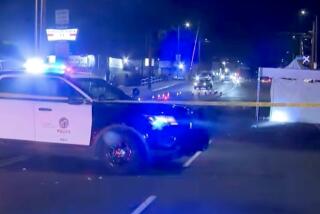Doctor’s prison sentence isn’t a sea change for cyclists
- Share via
Last year’s infamous incident on Mandeville Canyon Road -- in which a driver braked hard in front of a group of cyclists, causing two of them to be seriously injured -- began as so many anti-cyclist road-rage incidents do: The driver provoked the cyclists into responding to his verbal assault so he could “justify” using his vehicle to teach them a lesson. In fact, the driver, former emergency room doctor Christopher T. Thompson, was accused of previously using his vehicle to teach cyclists a lesson. On Friday, as reported by The Times in its Jan. 9 article, a chapter in that history came to a close as Thompson was sentenced to five years in prison.
There is no question that cyclists are almost always treated unfairly in the halls of a seemingly indifferent justice system, and for once, cyclists feel that the violent abuse they are regularly subjected to has been taken seriously. For that, the Los Angeles County district attorney’s office is to be commended.
But this was a stand-alone case that does not represent some sort of sea change in the way that vigilante violence against law-abiding cyclists is handled. We should remember that it took more than one assault with his weapon of choice before Thompson was sent to jail.
In fact, testimony about two prior alleged assaults, combined with Thompson’s own words to police officers -- “I wanted to teach them a lesson” -- and his ludicrous defense that he was merely slowing down to take photos of the cyclists led to his conviction. This is a particularly unique set of circumstances that may not be repeated.
Still, drivers who enforce some imaginary version of the vehicle code by assaulting law-abiding cyclists tend to do so repeatedly; for this reason, I advise cyclists to report these incidents to police. A driver with a reported history of violent assaults will be less likely to get away with claiming, as Thompson did, that it was all just “an unfortunate accident.” Real change will happen when law enforcement begins to take each report seriously, rather than waiting until serious injuries (or worse) have been inflicted.
But the most important change must occur within each of us, because when tempers flare on the road, nobody wins. The roads are common spaces, and their use is an ancient right for all -- except motorists. The state allows them to use the roads, and far too often that revocable privilege is misinterpreted by motorists as having some sort of superior right to the road. More often cyclists are endangered by drivers who are simply too distracted, or otherwise too careless, to even notice the cyclist whose life they have just endangered. And just as cyclists notice -- and remember -- the occasional dangerous motorist, it is the occasional rude cyclist that motorists notice and remember. It is these minority of bad actors on the road that lead to much of the resentment toward each other.
The real issue here is not “scofflaw cyclists” or “motorists hell-bent on killing cyclists;” it is competition for limited road space. For that, motorists owe cyclists a debt of gratitude; merely respecting our need for safety is all the thanks we need. Every cyclist you see on the road represents one less car contributing to congestion. Yes, you may occasionally have to slow down for a few seconds, but those few seconds are offset by the time you save for every car that is not on the road ahead of you. Cyclists also neither consume gasoline nor contribute to climate change, and they cause far less wear and tear on the road than cars. These are benefits that accrue directly to motorists in the form of less demand for limited resources, driving regulations and limited tax dollars.
Unfortunately, city transportation officials haven’t done their part to seed this change. The Los Angeles Bicycle Plan under review has been deemed so inadequate by cyclists that they have formed their own committee to propose a plan that would meet their actual needs. City officials shouldn’t ignore those who have real-world experience as cyclists on Los Angeles streets. Indeed, the lesson from the great cycling cities of the world is that if you make cycling feel safe for women and children, the number of cyclists on the road will increase. It’s time for some real leadership on this issue; is Los Angeles ready?
Attorney Bob Mionske, a former U.S. Olympic and professional cyclist, runs the Website bicyclelaw.com. He writes a bicycle law column for Bicycling magazine.
More to Read
A cure for the common opinion
Get thought-provoking perspectives with our weekly newsletter.
You may occasionally receive promotional content from the Los Angeles Times.










